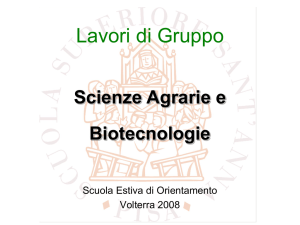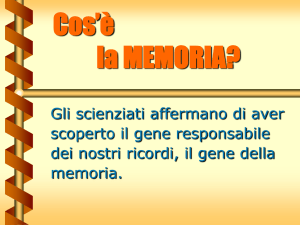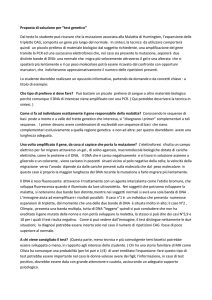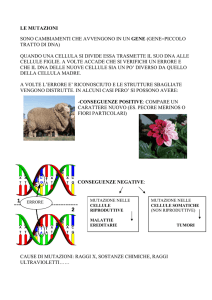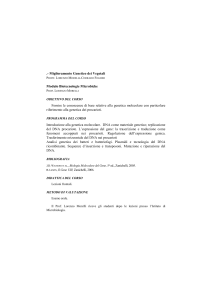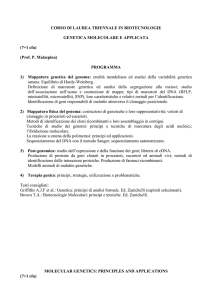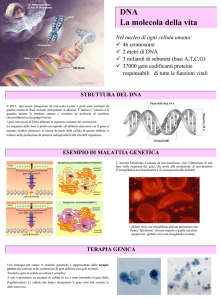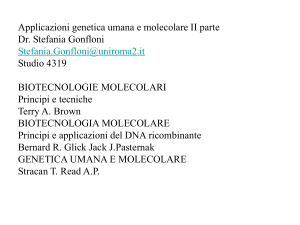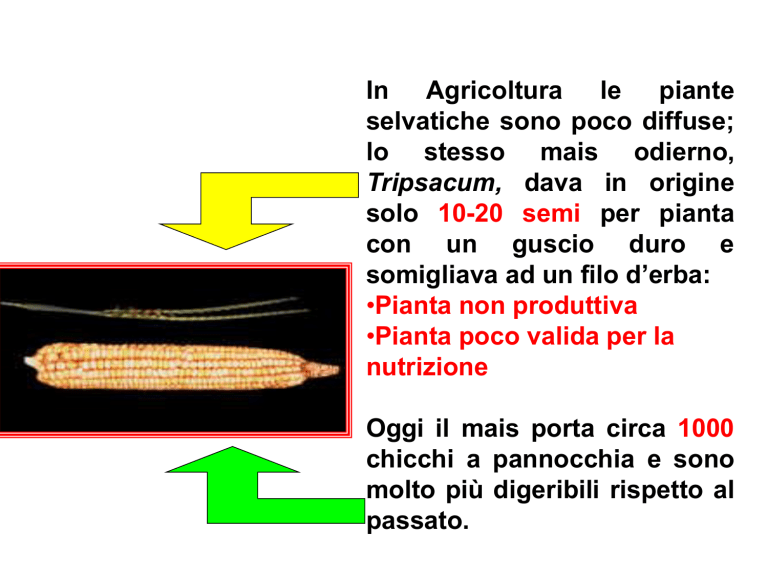
In Agricoltura le piante
selvatiche sono poco diffuse;
lo stesso mais odierno,
Tripsacum, dava in origine
solo 10-20 semi per pianta
con un guscio duro e
somigliava ad un filo d’erba:
•Pianta non produttiva
•Pianta poco valida per la
nutrizione
Oggi il mais porta circa 1000
chicchi a pannocchia e sono
molto più digeribili rispetto al
passato.
Plant Biotechnology
•Traditional
crossbreeding
Recombinant
DNA techniques
http://www.insp.mx/xcongreso/ponencias/5
www.quirkyworks.com/design/ Samples/plant-breeding.jpg
Agricultural Biotechnology
Species
Crossbreeding
Recombinant DNA
Related
Related/unrelated
10s of 1000s
1 – few
+
+
+
+
Efficiency
Susceptibility to external
gene influences
Genes shuffled in one
exepriment
Random insertion
Insecti and herbicides
Fertilizers
Pollution/run off
Potential toxins/risk
http://www.insp.mx/xcongreso/ponencias/5
Acri coltivati con piante transgeniche negli Stati Uniti
dal 1996 al 2001
Transgenic crop production area by country
Country
Area planted in 2000
(millions of acres)
USA
74,8
Argentina
24,7
Canada
7,4
China
1,2
South Africa
0,5
Australia
0,4
Mexico
minor
Bulgaria
minor
Romania
minor
Spain
minor
Germany
minor
France
minor
Uruguay
minor
Crops grown
soia, grano, cotone, colza
soia, grano, cotone
soia, grano, colza
cotone
grano, cotone
cotone
cotone
grano
soia, patata
grano
grano
grano
soia
How are Transgenic Plants
Produced?
Commonly Used Methods:
• Agrobacterium tumefaciens
• Gene Gun / Biolistics
• Electroporation
Power supply
Electroporation
Technique
Plant cell
Duracell
Protoplast
DNA containing
the gene of interest
DNA inside the
plant cell
The plant cell with
the new gene
In the process of causing crown gall disease, the bacterium
Agrobacterium tumefaciens inserts a part of its Ti plasmid—a region
called T-DNA—into a chromosome of the host plant.
A.Tumefaciens gall is not a tiny thing
Ti Plasmid
T-DNA
region
DNA between
L and R borders is
transferred to plant
as ssDNA;
Tumorproducing
genes
Opine catabolism
Virulence region
ORI
T-DNA encoded
genes can be
substituted by
target genes
Important genes encoded by
Ti plasmid
1. Cytokinins
(plant hormone for cell plant division and tumorous growth)
2. Enzymes for indoleacetic acid (auxin) synthesis
Another plant hormone (inducing stem and leaf elongation, inducing parthenocarpy and
preventing aging)
3. Enzymes for synthesis and release of novel plant
metabolites:
the opines (uniques amino acid derivatives)
the agrocinopines (phosphorylated sugar derivatives) .
Nopaline
Opines and agrocinopines are NUTRIENTS for A.tumefacies.
They can not be used by other bacterial species
It provides unique niche for A.tumefaciens
Opines are nutrients that are also
for quorum sensing
The plant cells start to secrete
the opines
from transferred bacterial T DNA
opine diffuses
into the surrounding cells
and serves as a signal molecules
for the conjugation
of the agrobacterium
(Quorum sensing)
Ti plasmid vector systems
are often working as binary vectors
T DNA region removed
Gene of interest
Plant selectable marker
Bacterial selectable
marker
Disarmed
Ti
plasmid
ori for E.coli
Virulence
region
ori for A. tumefaciens
HELPER
plasmid
ori for A. tum
DISADVANTAGE: Depending on the orientation,
plasmids with two different origins of replication may be unstable in E. coli
ADVANTAGE: small vectors are used, which increases transfer efficiency
from E. coli to Agrobacterium.
No intermolecular recombination is needed
T-DNA vector for plant transformation
Plant-specific
Promoter
Structural gene
(e.g. CRY)
Selectable marker
Herbicide/antibiotic
resistance
Plant-specific
Terminator
Left border
Right border
T-DNA:
Gets inserted into plant
chromosome
Design Transgenic Construct
Promoter
Transgene Terminator
pBS backbone
Design Transgenic Construct
Type of promoter Name
Comment
Constitutive
35S
Seed specific
Oleosin
Viral in origin,
high level of
expression
Expression is
found in the seed
Inducible
Ethanol
Activation of a
synthetic promoter
Promoters used for expression in
transgenic plants
35S, cauliflower mosaic virus 35S promoter
CaMV is a circular dsDNA genome virus
CaMV 35S is a strong promoter
that is active
in essentially all dicot plant tissues.
Procedure for creation a transgenic plant
1. Both plasmids are transfected into A.tumefaciens
2. Plant cell culture is infected with A.tumefaciens
3. Products of Vir genes excised gene of interest within T-DNA
and transfer it to plant chromosome
T-DNA Repeat
Polylinker
Kan-resistance gene
T-DNA Repeat
Gene of interest
4. Plant cells are selected on kanamycine
5. Presence of transgene confirmed by PCR
6. Whole plant could be grown from transformed cells !!!
Per vedere questa immagine
occorre QuickTime™ e un
decompressore GIF.
Per vedere questa immagine
occorre QuickTime™ e un
decompressore GIF.
Callus
specialized plant tissues that form
over a wound;
cork cambium may form
and the cells produced
will gradually seal the wound
Callous cells
are easiest cells to transform
(as their cell wall is very thin)
Protoplasts (no cells wall)
is even easier to transfrom,
but it is very difficult
to grow something viable from it.
Callus nay be produced by manipulation
with external concentration of plant hormones
Major Plant Hormones
Auxins
Natural auxin is indoleacetic acid (IAA)
Apical meristem is the major site
of auxin synthesis
Cytokinins
Structurally related to adenine
Produced by actively growing tissues
particularly roots, embryos, and fruits
auxin < CYTOKININ shoots
AUXIN > cytokinin roots
auxin = cytokinin undifferentiated callus
Produce callus transform callus
stimulate shooting by cytokinin addition
+ cytokinin
This procedure is easy
for dicotyledone plants
(legumes etc)
Biology of Plants, Raven et. al., Freeman Worth Publishing, 1999
T-DNA and any DNA contained within it are inserted into a plant
chromosome in the transgenic plant and then transmitted in a
Mendelian pattern of inheritance.
Per vedere questa immagine
occorre QuickTime™ e un
decompressore GIF.
Monocotyledones are not easy to handle –
callus is very difficult to be initiated, and
A.tumefaciens is not pathogenic for them
1. Pericarp sholud be pulled back and
the immature embryos (0.5 - 1.0 mm) are removed.
2. The immature embryos
are placed on
a callus induction medium
Transformation
is performed
by gene gun method
high osmotic media
prepare calli
for transfomation
plantsciences.montana.edu/ .../transform1.htm
DNA with desired gene and antibiotic resistance is
coated onto the surface of gold particles.
Calli are placed
in vacuum chamber,
Helium pressure
shot DNA into cells
Gene gun
Coating gold
particles with DNA
vacuum chamber
Calli remain
on the high osmotic media
for 20 hours
following shooting.
plantsciences.montana.edu/ .../transform1.htm
Each plant is from an independent
transformation event
• Each plant has DNA integrated at a different location
• Each plant is heterozygous for the introduced DNA
• Each plant may contain different numbers of insertions
Each plant is from an independent
transformation event
TF #2
TF #1
insertion in
chrom 2
insertion in
chrom 1
insertions in
chrom 2 & 3
TF #3
• Insertions at different locations
• Each plant is heterozygous for
insertion
• Plants may have multiple
insertions
Identificazione di un gene
Isolamento di un gene
Inserimento in un vettore
Introduzione in un ospite per amplificare
il gene
Selezione della sequenza genica
ESEMPIO DI PIANTA TRANSGENICA
RESISTENTE AGLI INSETTI
E’ stato osservato che certi bruchi che attaccano alcune piante,
muoiono dopo aver ingerito determinati batteri del terreno perchè
questi batteri producono una proteina tossica per il bruco.
Introducendo il gene del batterio responsabile di questa sostanza
tossica nella pianta, si ottiene una pianta transgenica indigesta per i
bruchi.
di patata transgenica
resistenti
Tignola del
PatateTuberi
Transgeniche
resistenti
allaalla
Tignola
deltubero
Tubero
Adulto di Dorifora su Pianta di
Melanzana
Le piante transgeniche di melanzana, cultivar Picentia,
che esprimono la tossina bt di Bacillus thuringiensis,
sono risultate fenotipicamente normali ed in grado di
resistere all'attacco di coleotteri.
Virioni di CMV visti
al microscopio elettronico
Il Virus del Mosaico del Cetriolo è tra i virus più studiati in campo vegetale. Ha un'elevatissima
diffusione ed è in grado di infettare più di 700 specie. Nel pomodoro causa serissimi danni alle
colture fino alla completa distruzione del raccolto nei casi più gravi. In molte aree agricole,
dove il pomodoro era la coltura leader, la sua coltivazione non è più possibile a causa
dell'endemica presenza di questo patogeno.
Pianta di pomodoro
Resistente al CMV
Sviluppo partenocarpico può essere ottenuto o selezionando varietà con partenocarpia genetica o spruzzando
il fiore in fitormoni auxinici, che inducono l'allegazione del frutto in assenza di fecondazione. I fitormoni
auxinici sono prodotti dall'ovulo fecondato e stimolano la crescita del frutto. Pertanto, per costruire piante
transgeniche partenocarpiche è necessario introdurre un gene che aumenti il contenuto e/o l'attività dei
fitormoni auxinici negli ovuli. Il gene "partenocarpico" deve quindi contenere due tipi di informazione:
a) regolativa, che determina non solo dove e quando il gene viene ad essere espresso (i.e. nell'ovulo e nei
tessuti derivati dall'ovulo), ma anche il livello di espressione;
b) strutturale, che determina il tipo di operazione biochimica da compiere (i.e. aumentare il contenuto e/o
l'attività di fitormoni auxinici).
Il pomodoro Flavz Savz sviluppato dalla Calgene non marcisce e non ammuffisce
in quanto è stato alterato in esso il gene per l'enzima responsabile della produzione
di etilene che induce la maturazione.
Plants synthetize ethylene by themselves (selfregulation of flowering)
ACC synthase
ACC oxydase
Gene Engineered Eternal Flowers
Made by antisense disruption of ACC synthase
Antisense gene is expressed in the plant
8 days after ethylene treatement.
9 days after pollination
transgenic
Non-transgenic
non-transgenic
transgenic
Fruit ripening and decay
(also ethylene dependent)
www.nf-2000.org/secure/ Fair/S1146.htm
Wild type (left) and antisense ACC oxidase (right) melons
harvested 38 days post-pollination, stored at 25ºC for 10 days
Herbicide Resistance
Introduction
Phosphoenolpyruvate + Shikimate-3-phospahte
EPSP Synthase
5-Enolpyruvylshikimate-3-phosphate (EPSP)
Tryptophan
Herbicide Resistance
Introduction
• ESPS synthase mutant
– Salmonella typhimurium aroA gene
– Pro101 to Ser101 mutation
– Reduce binding ability to glyphosate
RoundUp Sensitive Plants
Shikimic acid + Phosphoenol pyruvate
+ Glyphosate
Plant
EPSP synthase
X
3-Enolpyruvyl shikimic acid-5-phosphate
(EPSP)
Without amino acids,
plant dies
X
X
Aromatic
amino acids
X
RoundUp Resistant Plants
Shikimic acid + Phosphoenol pyruvate
+ Glyphosate
Bacterial
EPSP synthase
RoundUp has no effect;
enzyme is resistant to herbicide
3-enolpyruvyl shikimic acid-5-phosphate
(EPSP)
With amino acids,
plant lives
Aromatic
amino acids
Non-selective herbicides
(Roundup Ultra and Liberty)
Roundup® (chemical name: glyphosate)
Breaks down quickly in the soil,
eliminating
residual carry-over problems
and
reducing environmental impact.
Liberty® (glufosinate).
(Finale, Basta, Ignite)
Roundup Ready®
Liberty Link®
transgenic varieties
of common crops
completely resistant
to those herbicides
Herbicide Resistance
Western Blot
Final Test
Consumer Acceptance
RoundUp Ready Corn
Before
After
Reduction in herbicide usage with resulting
from the use of Roundup Ready soybeans (US).
From Doane Market Research, 2000.
Spoon of dirt in the honey barrel (fly in the ointment):
Roundup drift is possible,
so non-Roundup Ready varieties in the
neighborhood may suffer
Roundup 1/8 drift
Liberty 1/8 drift
Roundup reduced yield 82 percent; Liberty, 31 percent.
http://www.lsuagcenter.com/Communications/LouisianaAgriculture/agmag/images/43_3/crop_response3.jpg
-Carotene Pathway in Plants
IPP
Geranylgeranyl diphosphate
Phytoene synthase
Phytoene
Problem:
Rice lacks
these enzymes
Phytoene desaturase
ξ-carotene desaturase
Lycopene
Lycopene-beta-cyclase
Normal
Vitamin A
“Deficient”
Rice
-carotene
(vitamin A precursor)
The Golden Rice Solution
-Carotene Pathway Genes Added
IPP
Geranylgeranyl diphosphate
Daffodil gene
Phytoene synthase
Phytoene
Vitamin A
Pathway
is complete
and functional
Phytoene desaturase
Single bacterial gene;
performs both functions
ξ-carotene desaturase
Lycopene
Daffodil gene
Golden
Rice
Lycopene-beta-cyclase
-carotene
(vitamin A precursor)
BetaSweet® carrot
Contains approximately 50% more
Beta Carotene than normal carrot
Beta carotene
is a potent
cancer-fighting antioxidant.
dark maroon-purple color
(as also anthocyanine (another antioxidant) is added)
taste similar to regular carrots,
but have a very crispy texture,
which is easier to chew
Produced by Texas A&M University.
Use of Rice to prevent and treat
vitamin A and iron deficiencies
Iron deficiency is the most common nutritional disorder
• Iron-enriched transgenic rice:
•
•
1 gene increases Fe content ( ferritin)
2 genes increase Fe absorption ( phytate, cysteine)
DOUBLE TRANSGENIC RICE
b-carotene-enriched rice crossed with iron-enriched rice;
b-carotene enhances iron uptake
Free distribution to farmers in developing world
Metabolic Pathways are Complex
and Interrelated
Understanding pathways
is critical to developing
new products
Modifying Pathway Components
Can Produce New Products
Turn On Vitamin Genes =
Relieve Deficiency
Modified Lipids =
New Industrial Oils
Increase amino acids =
Improved Nutrition
MOLECULAR F(PH)ARMING
“The use of plants as bioreactors for the
production of recombinant proteins”
A wide range of proteins produced in
plants to date ranging from
pharmaceuticals to commodity enzymes
“Second Wave” of Agricultural
Biotechology
• First wave considered to be agricultural
traits e.g. herbicide and pest resistance,
relatively simple single gene traits.
• Concept of adding value to crops by using
them as production systems for novel
proteins
Overall Aims of Research
• To use plants as bioreactors(enzyme
factories) for the production of
industrial enzymes including animal
feed enzymes and cellulases for use in
biomass conversion
• To add value to an existing crop and
recover other co-products by
fractionation.
Currently most commodity enzymes
are produced in capital intensive
fermentation systems
An alternative production system is to
use transgenic plants and capture
solar energy
Why Alfalfa ?
• Abundant, widespread, hardy crop capable of 3 or
more harvests a year
• Low production costs, perennial
• Legume capable of vigorous growth without
irrigation and with less added fertilizer
• Technology already developed to extract proteinrich juice from alfalfa on a large scale
• Residue useable as feed, no waste management
problems
Fields of Transgenic Alfalfa
Will Replace Fermentation
Systems
Production of the Animal Feed
Enzyme Phytase in Transgenic
Alfalfa
1. Swine and poultry need phosphorus (P)
2. P is present in seeds such as soybean and
corn but it is bound in the form of phytic acid
3. Supplemental P is added to animal diets
which is an added cost and leads to excess P
in manure which causes environmental
pollution
If Phytase is added to feed the animals can use
the P in the diet, less P in the manure
Alfalfa Transformation and Field
Testing
• We made transgenic alfalfa by inserting a
gene from a fungus that makes phytase
• We grew the alfalfa in fields, it was
perfectly normal and the plants made high
levels of the enzyme
• We extracted juice from the plants and
made leaf meal which we added to animal
feed
Poultry Feeding Trials
• Feeding trials using whole
alfalfa juice and leaf meal
preparations from phytaseexpressing alfalfa show
that recombinant phytase
from alfalfa performs as
well as the microbial
enzyme
Swine Feeding Trials
Transgenic alfalfa juice
and leaf meal
preparations have both
been shown to
effective in swine
feeding trials. Pigs
actually like to eat
alfalfa!
Phytase As a Feed Enzyme in Fish
Farming
• Expanding industry
• Phosphorus
supplementation
required, especially if
diet is grain based
• Phytase effective in
fish
Waste management is
not a problem since
the fibrous material
remaining after juice
expression is still
a valuable ruminant
animal feed or can be used
as a substrate for bioethanol
or fermented to lactic acid
Methylmercury bioconcentrates in fish six to seven orders of magnitude
above concentrations found in polluted waters and constitutes 90–100%
of their total mercury content.
Scott P. Bizily et al., 2000
Mercurium
Ionic mercuruim,
easily eliminated
BIOMAGNIFICATION
Serious
environmental threat
as it enter chains
The problem?
• Methylmercury is
highly toxic!
Mercury Resistance
• Organomercurial lyase (merB)
• Mercuric Reductase (merA)
Bizily et al, 2000
Hypothesis:
• If plants are genetically engineered with
the bacterial mercury resistance genes
(merB and merA), then they should be
able to convert the very toxic
methylmercury (CH3Hg+) to the less
toxic, volatile elemental mercury (Hg0).
mer B, merA/merB-1, mer A, and wild-type plants
A: 0 ppm
CH3HgCl
B: 0.2 ppm
CH3HgCl
C: 1 ppm
CH3HgCl
D: 2 ppm
CH3HgCl
Bizily et al, 2000 (Figure 2A-D)
Vaccine production in edible plants
HBsAg – major antigen of hepB
virus
HBs Ag alone
is sufficient
to mount
immune response
Total immunization is a preventive answer
Transgenic lupin (Lupinus luteus L.) and
lettuce (Lactuca sativa L.)
with hepatitis HBs antigen
Kapusta, J. et al., FASEB J
Anti-HbsAg antibodies titre in
Mice fed with transgenic lupin callus
5 g in 1 dose
Anti-HbsAg antibodies titre in
Mice fed with transgenic lupin callus
1 g each of the 5 days
Three human volunteers
are fed with transgenic lettuce
200 g 1st dose,
150 g 2nd dose
Hepatitis B vaccine in Banana
Hepatitis B vaccine now costs $100 to $200 a dose
Vaccine banana would cost only a few cents per dose.
Just 24 acres of land
could produce enough bananas
to vaccinate
all Mexican children
under the age of 5.
Norwalk virus (calicivirus)
acute diarrhea
and vomiting
(2-3 days gastroenteritis),
abdominal cramps,
myalgias,
malaise,
headache,
nausea,
and low-grade fever
50% the outbreaks of acute infectious
nonbacterial gastroenteritis in the United States
the second most common cause
of illness in American families
(after common cold)
No treatment available
CDC data:
23 million US people infected by Norfolk annually.
1.4 million cases by salmonella.
79,000 by E. coli contamination
2,500 cases by listeriosis
Capsid-based plant-derived vaccine for
Norwalk virus
CT – inert component
of cholera toxin
(immunoboosting agent)
Hugh S. Mason et al, 1998
Serum antibody responses of mice fed with Norwalk potato (4g)
Human Trial of Norwalk vaccine
150 g of raw, peeled, diced potato
(215 - 751mkg of NVCP coat protein).
24 volonteers
(20 exp + 4 controls)
19 out of 20 start to produce
specific IgA antibody- secreting cells.
4 out of 20 start to produce
specific IgG antibodies
Side effects: nausea
in 20% of all volonteers
(raw potato)
Titer of serum IgG anti-NVCP:
1 : 67 before immunization
1 : 757 after immunization among responders
1 : 62,414 after real infection (fade after 2 years)
Tacket et al., The Journal of Infectious Diseases
2000;182:302-305
I rischi delle Biotecnologie
L’agricoltura è di per se una cosa non naturale perché comporta:
•Distruzione di foreste;
•Modifica dell’ambiente;
•Riduzione della biodiversità;
•Inquinamento ambientale.
Nessuna tecnologia è esente da rischi e da problemi, la domanda da porsi
é:
Il rischio vale la candela ?
Ovvero i benefici ottenuti
superano i rischi ?
Per l’agricoltura convenzionale
la risposta sinora è stata SI.
Le piante transgeniche comunque NON possono essere innocue del tutto.
Quali rischi sono possibili:
•Effetti tossici sull’uomo;
•Danni all’ambiente;
•Inutilità per i paesi ricchi;
•Gestione commerciale;
•Incapacità di risolvere la fame nel
mondo
Gli OGM scatenano allergie:
Il 2-4% dei bambini e l’1-2 degli adulti è allergico a soia, latte, farina, riso,
arachidi, crostacei etc
Le legislazioni dei paesi produttori salvaguardano ciò evitando la vendita
di prodotti che possono contenere proteine “allergeniche” se l’organismo
di partenza è allergenico.
Altro rischio paventato è di creare resistenze
indesiderate
agli
antibiotici
es
kanamicina,
neomicina etc.
Gli antibiotici servono per “trovare” tra le tante
cellule quelle trasformate, diventate resistenti agli
antibiotici, mentre le non-OGM sono sensibili e
periscono.
Il rischio è il passaggio di tale resistenza ai nostri
batteri intestinali.
Ciò è altamente improbabile; nel nostro intestino ci
sono miliardi di batteri che mutano continuamente
per cui le resistenze agli antibiotici sono sempre
presenti, ma manca la spinta selettiva ovvero non
ingeriamo gli antibiotici usati per selezionare gli
OGM.
Nel nostro DNA NON ci sono geni di vacca oppure
di mele eppure ingeriamo tutti i giorni carne e frutta.
Il 50% degli antibiotici è usato in zootecnia e con
carni crude e/o insaccati convogliamo molti batteri
resistenti agli antibiotici e selezionati dagli animali.
Un quesito è se possono le piante OGM
involontariamente trasmettere per riproduzione
sessuata ad altre piante il loro gene acquisito ?
SI
SI
SI
SI può evitare facendo:
-Integrare il gene nel DNA del cloroplasto
(molte piante trasmettono
i cloroplasti
per via materna per cui il polline non è
OGM);
•Usare piante maschio sterili;
•Non consentire coltivazioni non-OGM
vicino ad OGM;
Gli OGM non riducono la biodiversità.
A ridurla è stato l’uomo per aspetti commerciali; le
specie più produttive sono favorite per il mercato e
oggi ci sono solo 3-4 specie di mele rispetto alle 200
varietà di un secolo fa.
« Junk » DNA (1)
• nei mammiferi i geni rappresentano il 2-5% del DNA totale
• sequenze regolatorie e introni rappresentano un altro 2%
Qual’e’ la funzione del restante 93-96 %?
Il ruolo di questo DNA non e’ stato scoperto ma fino a
pochissimo tempo fa si pensava che non avesse funzioni.
questo 93-95% e’ percio’ chiamato « junk DNA ».
Il « Junk DNA » non codifica per nessuna proteina.
«Junk » DNA (2)
Number of genes of various organisms
Organismi complessi
hanno piu’ geni di
organismi semplici
35 000
30 000
25 000
20 000
15 000
10 000
50 00
0
Bacteri um
Ye ast
In sect
Wo rm
Pla nt
Huma n
Percentage of genes compared to
non-coding regions in various organisms
Non-coding
regions
100%
Genes
80%
60%
40%
20%
0%
Bacterium
Yeast
Worm
Insect
Human
La proporzione di geni
sul DNA totale e’ piu’
bassa in organismi
complessi
« Junk » DNA (3)
Comunque non ci sono prove che il « junk DNA » non ha funzioni.
Anzi la complessita’ del sistema di regolazione genica degli
organismi superiori potrebbe lasciar supporre un qualche ruolo.
« Junk » DNA (4)
Il fatto che il « junk DNA » possa avere un qualche ruolo e’
fondamentale per l’ingegneria genetica e per la piante transgeniche
in particolare.
Infatti nel produrre una pianta transgenica si assume che
l’inserzione di DNA in una regione di « junk DNA » non causi altre
alterazioni nelle funzioni della pianta.
Se questa assunzione non e’ piu’ vera significa che ci possiamo
aspettare alterazioni imprevedibili.



